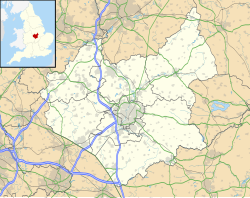| Slawston | |
|---|---|
 All Saints church, Slawston | |
Location within Leicestershire | |
| Population | 191 (2011 Census) |
| OS grid reference | SP 77821 94435 |
| District | |
| Shire county | |
| Region | |
| Country | England |
| Sovereign state | United Kingdom |
| Post town | Market Harborough |
| Postcode district | LE16 |
| Dialling code | 01858 |
| Police | Leicestershire |
| Fire | Leicestershire |
| Ambulance | East Midlands |
| UK Parliament |
|
Slawston is a village and civil parish in the Harborough district of Leicestershire, England, north-east of Market Harborough. According to the 2001 census the parish had a population of 143, including Welham and increasing to 191 at the 2011 census. [1] The parish includes the deserted village of Othorpe at grid reference SP770956 . Slawston is located roughly 1 km away from Medbourne.


